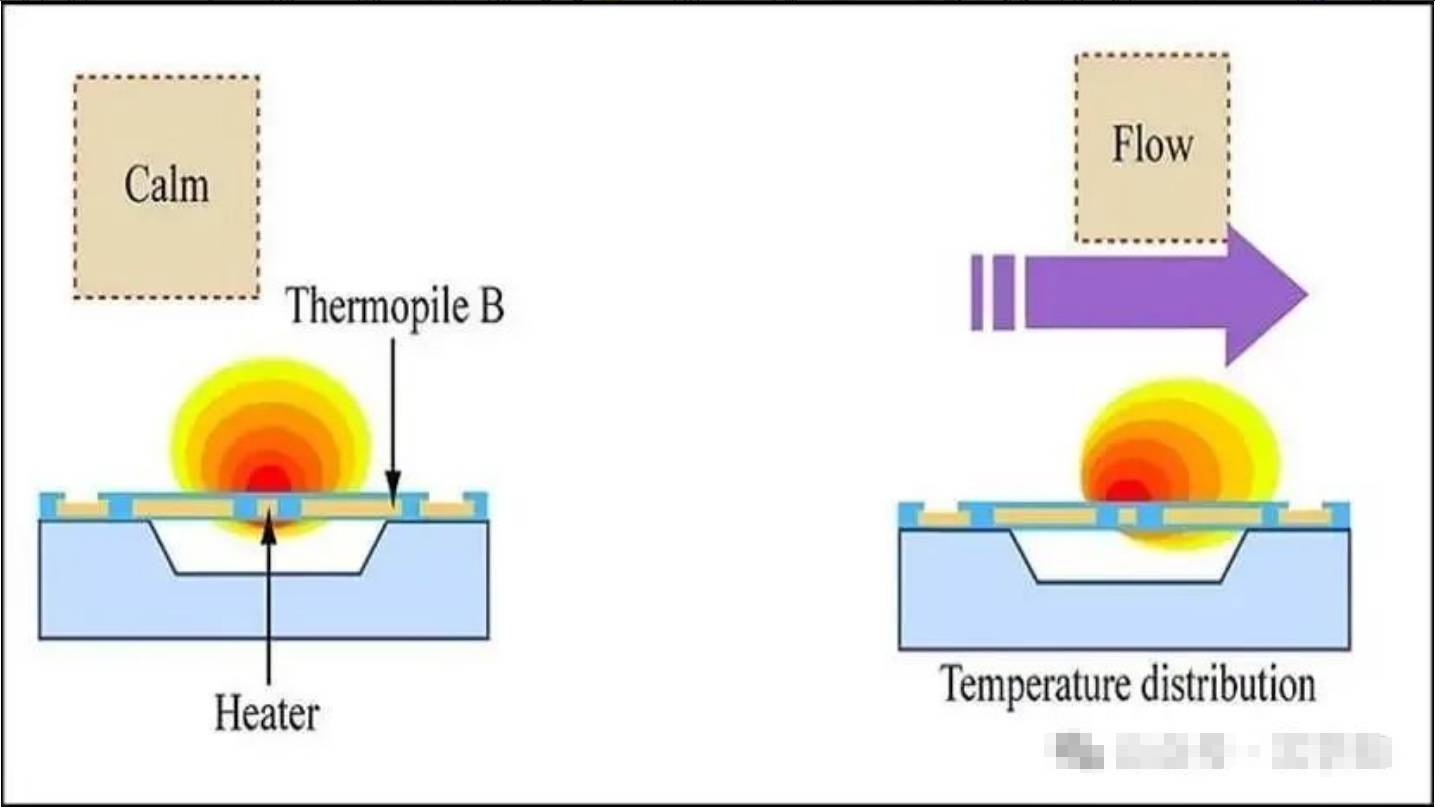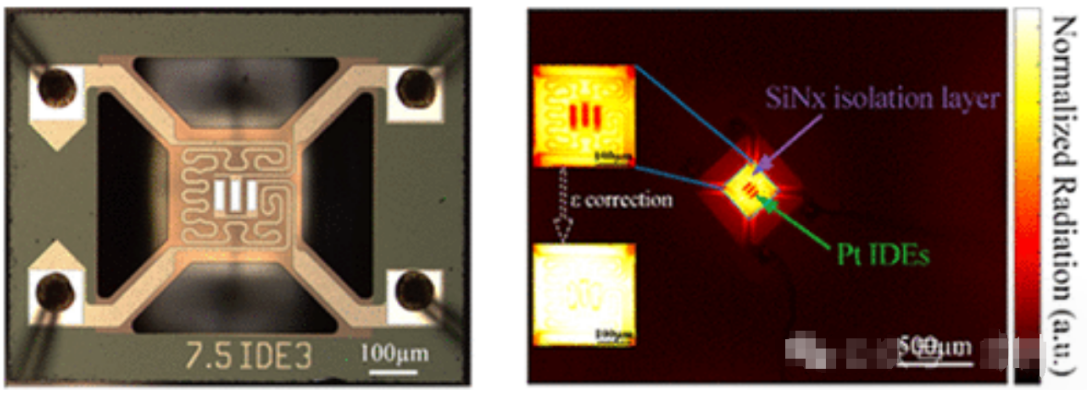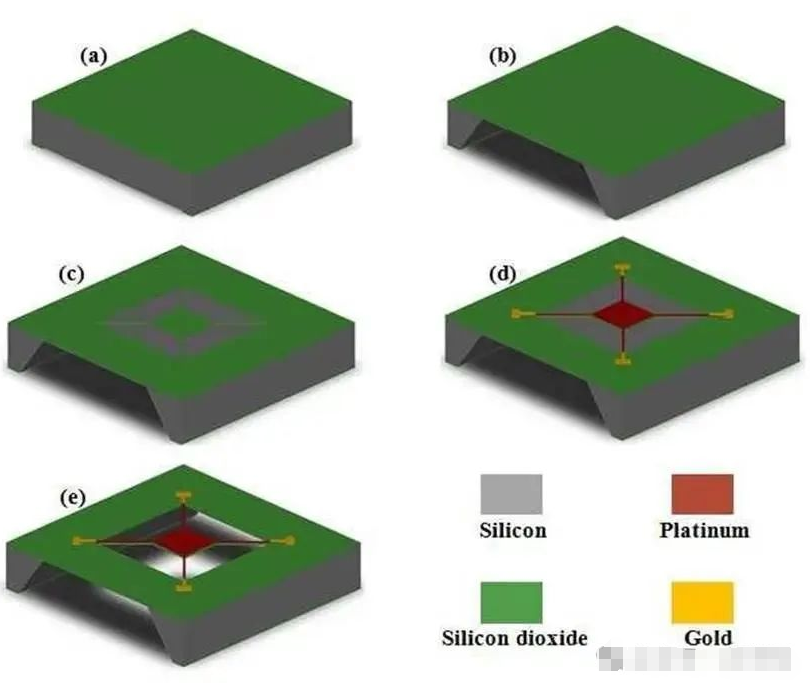
MEMS thermal devices can be divided into two categories according to their functions: thermal sensors and thermal actuators. Thermal sensors mainly include thermal flow sensors, differential pressure sensors, and thermal gas sensors. Thermal actuators include thermal expansion actuators and Joule thermal actuators.
The principle of thermal flow sensors is to measure flow by using the heat conduction or thermal convection effect of fluid flow on the heat source. The most common method is the constant temperature difference method. A heating element (heat source) and a temperature sensor are set in the flow channel. When the fluid flows, the heat of the heat source is taken away. The temperature difference between the heat source and the fluid is kept constant by adjusting the heating power. The heating power is proportional to the flow rate. The differential pressure sensor uses the difference in thermal convection or thermal conduction caused by the pressure difference to measure the pressure difference, which is similar to the principle of thermal flow.

Figure Schematic diagram of thermal flow sensor principle
Thermal gas sensors include metal oxide type, catalytic combustion type and thermal conductivity type. Metal oxide sensors are a type of sensor developed based on the gas-sensitive properties of metal oxide semiconductor materials. The core principle is to use the change in the conductivity or resistance of the material when the gas undergoes an oxidation-reduction reaction with the metal oxide surface at a certain temperature, thereby realizing the detection of the gas. The principle of catalytic combustion gas sensors is that the combustible gas releases heat when it burns on the surface of the catalytic layer, the temperature of the heating element rises, and the combustion heat is detected by the change in resistance. It is used in the detection of flammable and explosive gases such as methane and propane. Thermal conductivity gas sensors use the different thermal conductivities of different gases. When the measured gas flows through the heating element, the change in thermal conductivity causes the temperature of the element to change. The temperature change is detected by a resistor (such as a platinum resistor), and is used in mixed gas composition analysis (such as H₂, CO₂ concentration monitoring).

Figure MEMS metal oxide gas sensor and thermal effect
Thermal expansion actuators use the bending deformation of a double-layer structure (such as a silicon-metal composite layer) due to the difference in expansion coefficients after heating to drive the movement of micromechanical structures, such as MEMS valves and MEMS switches. Joule thermal actuators generate heat by passing current through a resistor and are used for micro-heating, MEMS thermal print heads, or chemical reaction heating.

Figure Thermal Foaming Nozzle Chip
The performance of MEMS thermal devices is highly dependent on the thermal conductivity, resistivity, high temperature resistance and compatibility of the material. Commonly used materials include metals and metal alloys, such as Pt, W, NiCr, NiPt and semiconductor materials such as polysilicon. Metal Pt has high resistivity, high temperature resistance and strong oxidation resistance. It is often used as a standard heating material. The heating temperature can theoretically reach above 600°C, and is commonly used at around 400°C. The resistivity of metal W is stable at high temperatures, and its TCR is slightly lower than that of Pt. It is suitable for high temperature scenarios, and the maximum heating temperature can reach 1000°C. The typical composition of alloy NiCr is 80% Ni+20% Cr, and the maximum heating temperature is 600°C. Cr is easily oxidized at high temperatures, resulting in resistance drift. The typical composition of alloy NiPt is 90% Ni+10% Pt, and the maximum heating temperature can reach 700°C. Its corrosion resistance is better than NiCr. Polysilicon needs to be doped (such as P, B) to improve conductivity. It is fully compatible with CMOS and MEMS processes. Depending on the doping concentration, the maximum heating temperature can reach 800°C, but the temperature resistivity is greatly affected by the doping concentration and the resistance drift is large. In MEMS thermal devices, Pt is the most widely used, followed by polysilicon.
So how to achieve the heating function? As we all know, substrate silicon is a good thermal conductor and cannot effectively gather heat, so structural and film layer design is required. First, through the design of thermal resistance, such as serpentine or spiral resistance, the resistance length is increased and the chip area is reduced. Second, an insulating layer such as SiO₂/Si₃N₄ is deposited on the silicon substrate by sputtering or evaporation process. The thickness is usually several hundred nanometers to micrometers. Third, a suspended structure needs to be formed, and the supporting structure is released through the MEMS process to make the heating element suspended (such as a cantilever beam), reducing heat conduction to the substrate and improving heating efficiency.

Figure Schematic diagram of microheater manufacturing process
Share